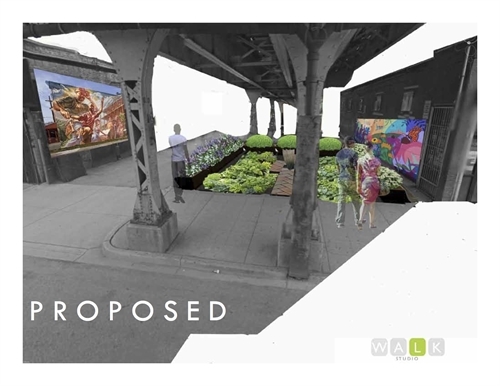
Jimmy Guzman
With its strength in cultural richness, Bronzeville highlights history to enliven the present.
 By Marisa Novara and MPC Research Assistant Jason Brown
By Marisa Novara and MPC Research Assistant Jason Brown - October 10, 2013
When you think commercial development, installing art may not spring immediately to mind, yet the Bronzeville Alliance and its partner organizations have made art a priority in developing the 47th Street corridor and surrounding areas. Bronzeville has been a pillar of African-American culture and community in Chicago since the early 20th century, so it should be no surprise that Bronzeville’s future is being paved by memorializing their famous past.

Vibrant beauty is restored to Dr. Weber's "This World is Not Our Home" along 40th Street.
Bronzeville Retail Initiative
On 40th Street, past beauty is paving the way for future development as artist Dr. C. Siddha Weber restores his mural “The World is Not Our Home,” originally painted in 1981. Dr. Weber’s repaired artwork has caught the community’s attention, with passersby stopping to ask questions and even offering to help. Murals and public art like Dr. Weber’s contribution to the community inspire others toward action and pave the way for public engagement.
Meanwhile, Jimmy Guzman and Quad Communities Development Corporation (QCDC) have been engaging the community youth to enhance 47th Street. Last year, QCDC received a grant from the Illinois Violence Prevention Authority to develop a Placemaking project in which 30 youth participated in a 10-week program to create graphic design pieces that are now being installed on the roll-up doors along the corridor. Long a staple of after-hours security, these doors are being transformed from blank walls to lively canvases. Students’ works were inspired by themes such as pride in community and famous residents of Bronzeville. As you can see from the pictures to the left and above, the pieces are hard not to notice, and are proudly branded with “Bronzeville.” Jimmy notes, “We work off of the broken windows concept. Placemaking and beautification are essential deterrents, and it allows youth to have a sense of ownership and pride about the history of the community.” These actions can be the first steps toward establishing an atmosphere for new shops to thrive.

MADD Rhythms performs on a People Spot in Bronzeville
QCDC
Bronzeville leaders are not content to just make these key corridors into open galleries—why not make them dance halls, music venues and eateries as well? Throughout the summer, Bronzeville Nights brought events to the neighborhood that enlivened all the senses and displayed a willingness to put on dance shoes as well as work boots. Drawing people from around the city to hear musical guests such as the Phil Seed Trio, Paul Branton and M.A.D.D. Rhythms, taste the diverse flavors of local grub at C’est Si Bon!, go for a bike ride or stroll down 47th Street, the Bronzeville Nights series was a great example of the community’s creative approach to development. As the summer progressed, QCDC saw more partners come on board as DIY transportation became part of the conversation and DIVVY and Bronzeville Bikes were promoted through a partnership with the Active Transportation Alliance.
From involving youth in restoring old art and creating new, to engaging and promoting local cultural and commercial assets, recent efforts are advancing the Bronzeville Retail Initiative Task Force’s recommendations made back in the summer of 2011. Key points in the Task Force’s recommendations were to build on the existing neighborhood assets such as the Harold Washington Cultural Center and the Little Black Pearl, while focusing on connecting to and creating new opportunities in the region. Specifically, the Task Force called on community leaders to “Address safety and perceptions of safety” and “Create new draws to the area to import new spending.” Getting students and artists out to enhance the area will not only diminish perceptions of violence as people go about peaceful work, but also establish a context where people from the community—young and old—can create lasting ties. Furthermore, the Bronzeville Retail Initiative’s recommendation to “Create a new Special Service Area (SSA) along 47th Street” can only be advanced by the attention that these Placemaking efforts will draw, as it becomes more attractive to commercial and retail investment. Special Service Areas, which are made up of contiguous businesses that agree to pay an added tax that they then use to pay for collective benefits, are a great vehicle for the flexible funds needed to fuel creative improvements. The recent creation of a new SSA on 47th St in the 3rd Ward (adjoining the existing in the 4th Ward) is a great sign of things to come.
We applaud the Bronzeville Alliance and QCDC’s creative approach to commercial development, and we look forward to seeing what they’ll come up with next.

QCDC has adopted the 47th St Green Line station and plans to create an under-El garden.
Credit: Dave Walker, WALK Studios